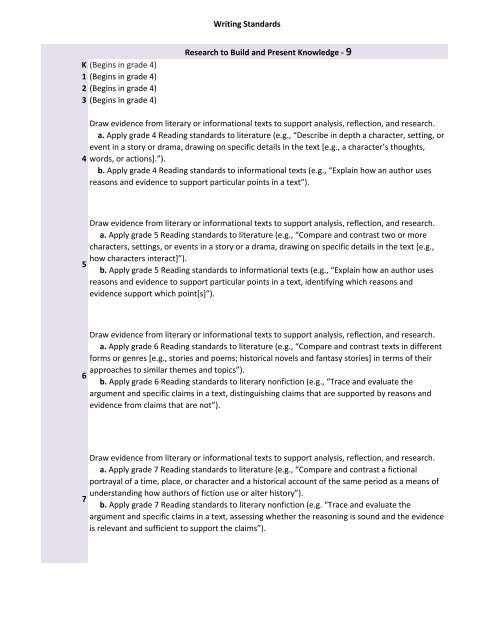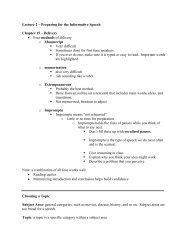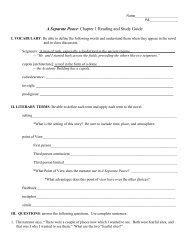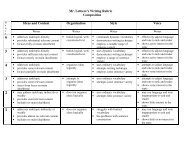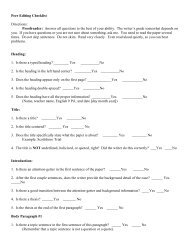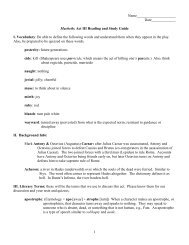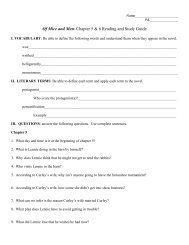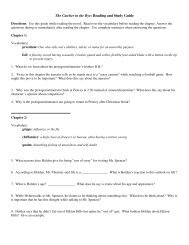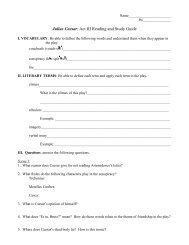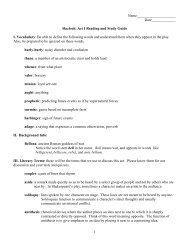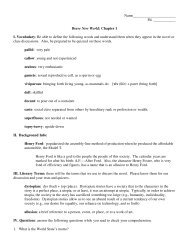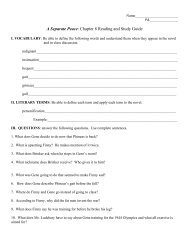Resarch
Resarch
Resarch
You also want an ePaper? Increase the reach of your titles
YUMPU automatically turns print PDFs into web optimized ePapers that Google loves.
Writing StandardsK (Begins in grade 4)1 (Begins in grade 4)2 (Begins in grade 4)3 (Begins in grade 4)Research to Build and Present Knowledge - 94Draw evidence from literary or informational texts to support analysis, reflection, and research.a. Apply grade 4 Reading standards to literature (e.g., “Describe in depth a character, setting, orevent in a story or drama, drawing on specific details in the text [e.g., a character’s thoughts,words, or actions].”).b. Apply grade 4 Reading standards to informational texts (e.g., “Explain how an author usesreasons and evidence to support particular points in a text”).5Draw evidence from literary or informational texts to support analysis, reflection, and research.a. Apply grade 5 Reading standards to literature (e.g., “Compare and contrast two or morecharacters, settings, or events in a story or a drama, drawing on specific details in the text [e.g.,how characters interact]”).b. Apply grade 5 Reading standards to informational texts (e.g., “Explain how an author usesreasons and evidence to support particular points in a text, identifying which reasons andevidence support which point[s]”).6Draw evidence from literary or informational texts to support analysis, reflection, and research.a. Apply grade 6 Reading standards to literature (e.g., “Compare and contrast texts in differentforms or genres [e.g., stories and poems; historical novels and fantasy stories] in terms of theirapproaches to similar themes and topics”).b. Apply grade 6 Reading standards to literary nonfiction (e.g., “Trace and evaluate theargument and specific claims in a text, distinguishing claims that are supported by reasons andevidence from claims that are not”).7Draw evidence from literary or informational texts to support analysis, reflection, and research.a. Apply grade 7 Reading standards to literature (e.g., “Compare and contrast a fictionalportrayal of a time, place, or character and a historical account of the same period as a means ofunderstanding how authors of fiction use or alter history”).b. Apply grade 7 Reading standards to literary nonfiction (e.g. “Trace and evaluate theargument and specific claims in a text, assessing whether the reasoning is sound and the evidenceis relevant and sufficient to support the claims”).
Writing StandardsResearch to Build and Present Knowledge - 98Draw evidence from literary or informational texts to support analysis, reflection, and research.a. Apply grade 8 Reading standards to literature (e.g., “Analyze how a modern work of fictiondraws on themes, patterns of events, or character types from myths, traditional stories, orreligious works such as the Bible, including describing how the material is rendered new”).b. Apply grade 8 Reading standards to literary nonfiction (e.g., “Delineate and evaluate theargument and specific claims in a text, assessing whether the reasoning is sound and the evidenceis relevant and sufficient; recognize when irrelevant evidence is introduced”).9 - 10Draw evidence from literary or informational texts to support analysis, reflection, and research.a. Apply grades 9–10 Reading standards to literature (e.g., “Analyze how an author draws onand transforms source material in a specific work [e.g., how Shakespeare treats a theme or topicfrom Ovid or the Bible or how a later author draws on a play by Shakespeare]”).b. Apply grades 9–10 Reading standards to literary nonfiction (e.g., “Delineate and evaluatethe argument and specific claims in a text, assessing whether the reasoning is valid and theevidence is relevant and sufficient; identify false statements and fallacious reasoning”).11 - 12Draw evidence form literary or informational texts to support analysis, reflection, and research.a. Apply grades 11–12 Reading standards to literature (e.g., “Demonstrate knowledge ofeighteenth-, nineteenth- and early-twentieth-century foundational works of American literature,including how two or more texts from the same period treat similar themes or topics”).b. Apply grades 11–12 Reading standards to literary nonfiction (e.g., “Delineate and evaluatethe reasoning in seminal U.S. texts, including the application of constitutional principles and use oflegal reasoning [e.g., in U.S. Supreme Court Case majority opinions and dissents) and thepremises, purposes, and arguments in works of public advocacy (e.g., The Federalist, presidentialaddresses]”).


